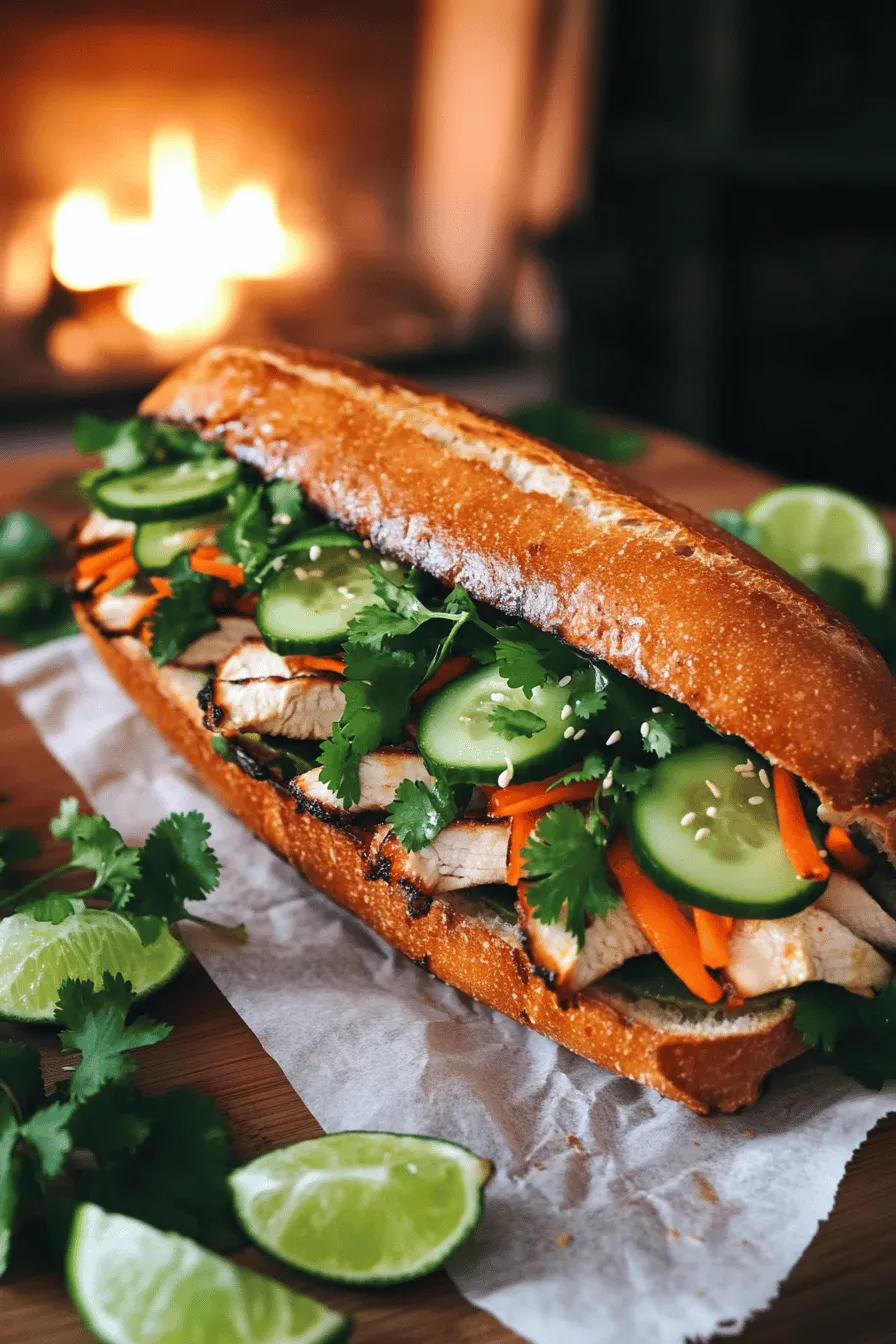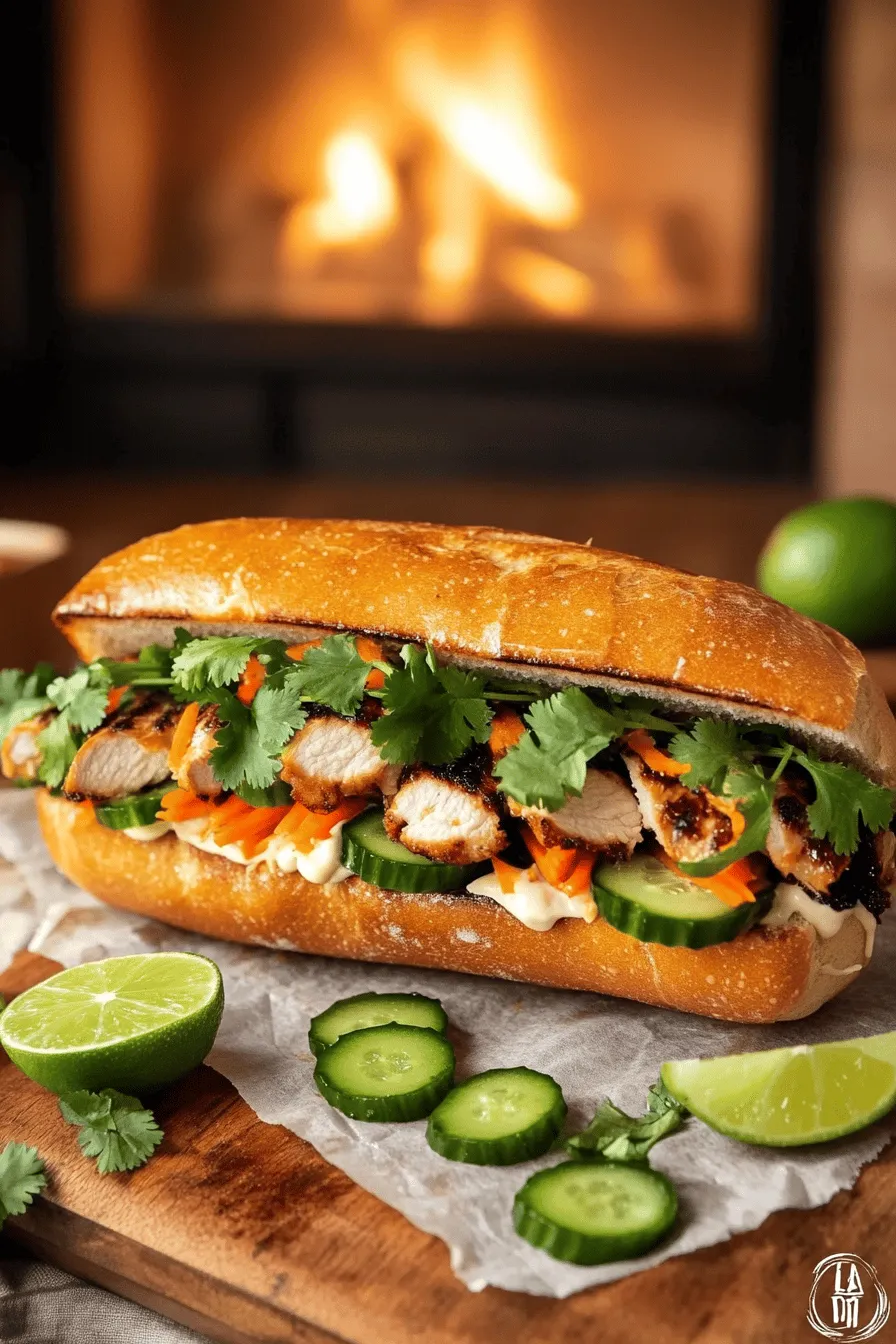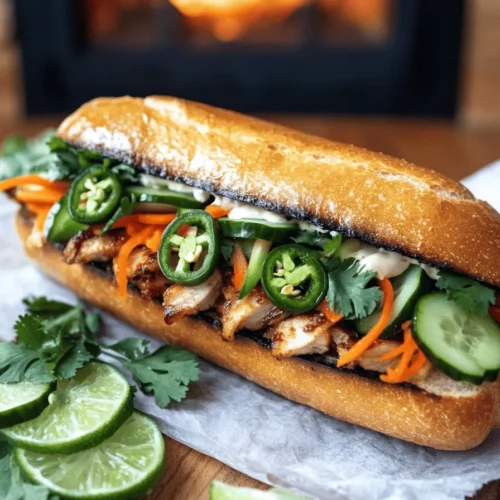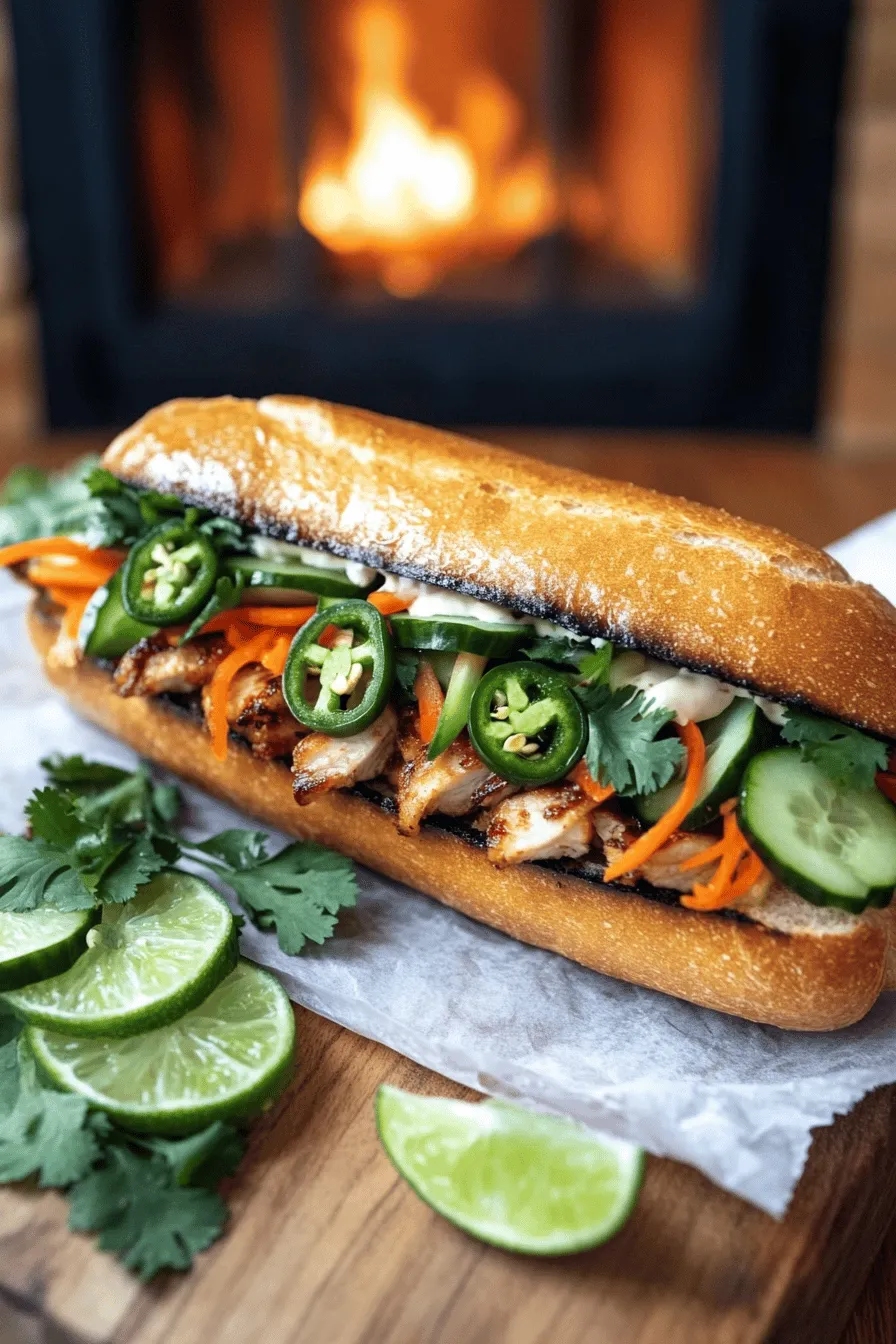Have you ever tasted a Banh Mi sandwich? It’s not just food; it’s a flavorful story on your plate. This delicious Vietnamese street food blends crispy bread, savory meats, and fresh veggies, all wrapped in history and culture. Join me as we journey through the origins, key ingredients, and variations of this beloved dish. Whether you crave a traditional bite or want to try making it at home, let’s dive into the tasty world of Banh Mi!
What is the History Behind Banh Mi Sandwich?
Banh Mi sandwiches have a rich and colorful past. They first appeared in Vietnam during French colonial times. The French brought their baguettes and spread culinary skills, which mixed with local flavors. This blend led to the birth of Banh Mi, a unique street food.
How did Banh Mi originate?
Banh Mi’s origin is a tale of fusion. The French introduced the baguette, while Vietnamese cooks added local ingredients. These included pickled veggies, fresh herbs, and savory meats. This combination created a tasty, handheld meal, perfect for busy streets.
What cultural influences shaped Banh Mi?
Many cultures shaped Banh Mi. The French influence is clear in the bread and certain spreads. However, Vietnamese traditions add depth. Ingredients like cilantro, jalapeños, and pickled carrots reflect the country’s rich food culture. Each bite tells a story of history and blending traditions.
How has Banh Mi evolved over time?
Banh Mi has evolved greatly since its inception. Today, you can find many variations. Street vendors offer classic options with pork or chicken. Chefs now create gourmet versions with unique ingredients. Even plant-based options are popular, showing Banh Mi’s flexibility. It’s a sandwich that keeps growing and adapting, much like the people who love it.
For a taste of this history, try the Full Recipe and make your own Banh Mi at home.
What Are the Key Ingredients in a Banh Mi Sandwich?
Banh Mi sandwiches mix flavors and textures in a special way. The bread is very important. The best choice is a Vietnamese baguette. It has a crispy crust and a soft center. This bread holds all the tasty fillings. You can also use any good crusty bread if you cannot find Vietnamese baguette.
What types of bread are used for Banh Mi?
Banh Mi needs bread that is light and airy. The crust should be crunchy. A traditional Vietnamese baguette is best. It is made with rice flour, which gives it a unique taste. Other types of baguette can work too. Look for bread that is fresh and crusty for the best results.
Which proteins are popular in Banh Mi recipes?
The protein you choose can change the whole flavor of the sandwich. Popular choices include chicken, pork, beef, and tofu. Each protein brings its own taste. For example, grilled pork is sweet and smoky. Tofu is great for a vegan option. It absorbs the sauce and adds a nice texture. Use about one cup of cooked protein for each sandwich.
What pickled vegetables are typically included?
Pickled veggies add crunch and tanginess. The classic choices are pickled carrots and daikon radish. They balance the rich flavors of the meat. You can make your own pickles by mixing equal parts vinegar and sugar. Let the veggies soak for at least 30 minutes. This will help them get the right flavor. You can also add sliced cucumbers for extra freshness.
A Banh Mi sandwich is a tasty mix of flavors and textures. With the right ingredients, you can create your own at home. You can find the full recipe for Banh Mi Delight in this article, which shows you how to assemble these delightful sandwiches.

How Can I Make Banh Mi at Home?
Making banh mi at home is not hard. You only need a few fresh ingredients. I love the mix of flavors and textures. Here’s how you can prepare this tasty sandwich.
What steps are involved in preparing a Banh Mi?
1. Prepare the Pickles: First, you need to pickle carrots and daikon. Mix equal parts vinegar and sugar with a pinch of salt. Let them sit for at least 30 minutes. This step adds great flavor.
2. Toast the Baguette: Preheat your oven to 375°F (190°C). Slice the baguette in half. Toast it for about 5-6 minutes. You want it crispy but soft inside.
3. Assemble the Sauce: In a bowl, mix mayonnaise with soy sauce and sriracha. This spicy spread gives your sandwich a kick.
4. Layer the Ingredients: Spread the sauce on both sides of the baguette. Start with your cooked protein, like chicken or tofu.
5. Add Fresh and Pickled Veggies: Next, layer on sliced cucumbers, pickled carrots, and daikon. Top it with fresh cilantro and jalapeño slices.
6. Season and Close: Lightly sprinkle with salt and pepper. Press down gently to keep all the flavors together.
7. Slice and Serve: Cut the sandwich diagonally. This makes it easy to eat. You can serve it on a wooden board or in a basket.
What variation of Banh Mi can I try?
You can try many variations of banh mi. For a vegan option, use tofu or marinated mushrooms. If you want a gluten-free version, swap the baguette for gluten-free bread. You can also change proteins. Try beef or shrimp for a different taste.
How can I customize my Banh Mi with different ingredients?
You can add many ingredients to make your banh mi unique. Try adding avocado or radishes for a fresh crunch. You can also use different sauces, like hoisin or chili garlic sauce, to change the flavor. The key is to mix and match until you find your favorite combination.
For the complete recipe, check out the Full Recipe section. Enjoy your homemade banh mi!
What Are Some Popular Variations of Banh Mi?
Banh mi brings joy to many taste buds. You can find many banh mi variations that cater to different diets and preferences.
Are there vegan options for making Banh Mi?
Yes, there are great vegan banh mi options! You can use marinated tofu or tempeh as your protein. Both options soak up flavors well. Add fresh vegetables like cucumbers, carrots, and daikon. You can also add avocado for creaminess. For the sauce, mix vegan mayo with soy sauce and sriracha. This creates a tasty spread that keeps things interesting.
How can I prepare a gluten-free version of Banh Mi?
To make a gluten-free banh mi, start with gluten-free bread. Look for gluten-free baguettes at your local store. You can also use lettuce wraps for a fresh twist. For the filling, choose cooked chicken, pork, or grilled vegetables. Just ensure your sauces and pickled veggies are gluten-free. Always check labels to avoid hidden gluten.
What unique flavor profiles can I explore in Banh Mi variations?
Banh mi can surprise you with its many flavors. Try adding grilled eggplant or spicy kimchi for a twist. You can also play with herbs like basil or mint. These can brighten your sandwich and add freshness. Mixing different proteins, like spicy sausage or smoked tofu, creates rich flavors. Each bite can be a new adventure.
For a detailed recipe to start your journey, check out the Full Recipe of Banh Mi Delight.

Where Can I Find the Best Banh Mi?
When I crave Banh Mi, I hunt for the best spots. Each place has its own twist. If you’re in a big city, search for local favorites online. You’ll find gems that locals love. Food blogs often list the best Banh Mi in your area.
Food trucks are another great choice. They offer fresh Banh Mi made right in front of you. The flavors often burst with excitement. Plus, food trucks are fun. You get to enjoy your meal outdoors, soaking in the vibe of the street.
For takeout, I have a few handy tips. First, call ahead to avoid long waits. When ordering, ask for extra pickled veggies. They add a zesty crunch. Don’t forget to check for spice levels. Some sandwiches can be quite hot!
You can find a full recipe to make your own Banh Mi at home. This way, you can enjoy it anytime.
What Makes Banh Mi a Unique Culinary Experience?
Banh Mi shows the heart of Vietnamese cooking. This sandwich combines French and Vietnamese flavors. It uses a crispy baguette, which is a nod to French influence. Inside, you find layers of fresh and pickled veggies. These include cucumbers, carrots, and daikon. The crunch adds a fun texture.
How does Banh Mi reflect Vietnamese culinary traditions?
Banh Mi is more than just food; it tells a story. It mixes local tastes with history. In Vietnam, street food is a big part of life. You can find many vendors selling Banh Mi. Each vendor has their own twist on the recipe. This reflects the creativity and culture of the community.
What are different serving styles for Banh Mi?
Banh Mi comes in many styles. You can enjoy it with various proteins like chicken, pork, or tofu. Some people like extra spice, adding jalapeños or hot sauce. Others keep it simple with just veggies and sauce. Each style offers a unique flavor and experience.
How is Banh Mi being adapted in modern cuisine?
Today, chefs are getting creative with Banh Mi. They blend different flavors from around the world. You might see Banh Mi with unique toppings like kimchi or avocado. This fusion shows how food evolves. It keeps the tradition alive while inviting new tastes. Banh Mi is now a global favorite. You can even make your own at home using the Full Recipe I shared.
Banh Mi is more than just a sandwich; it tells a rich story. We explored its history, cultural influences, and ingredients. You learned how to make Banh Mi at home and discovered tempting variations. The best spots to grab this tasty treat were shared, too. Banh Mi connects you to Vietnamese culture and flavors. With every bite, you savor a unique blend of tradition and modernity. Enjoy crafting and tasting your own Banh Mi creations!







